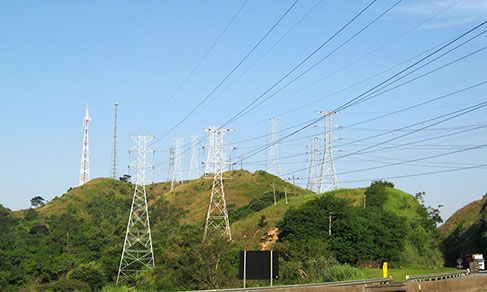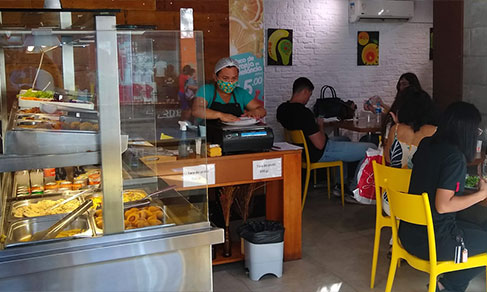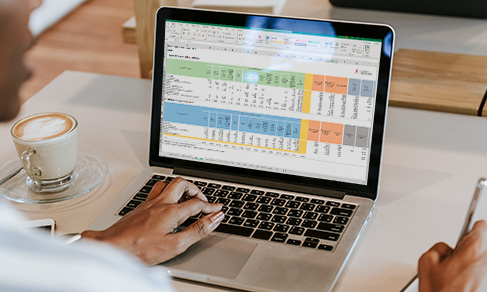Nossos serviços estão apresentando instabilidade no momento. Algumas informações podem não estar disponíveis.
SCN - System of National Accounts
 Experimental Statistics
Experimental Statistics
About - 2018 Supply and Use Tables by Federation Unit
The System of National Accounts - SNA is based on the identity between the supply and demand of goods and services. On the demand side, every good and service produced in an economy is consumed (as intermediate consumption in the production process or as final consumption by households and governments), stocked, destined to investment or exported. Part of the demand is also supplied by imported goods and services. Therefore, on the supply side, every good and service used in an economy is either produced in that economy or imported.
Supply and Use Tables - SUTs show the relation between supply and demand, detailing flows by activity and product and the generation of value added in each economic activity. At the national level, the IBGE publishes these matrices since the 1990s. The Supply and Use Tables by Federation Unit improve the detailing of such information for the 27 Brazilian Federation Units.
The experimental statistics now released show the complete SUTs, including the supply and demand, as well as provide an overview of the economy in each Brazilian Federation Unit.
These experimental statistics were developed from data sources usually used to compile the Brazilian Systems of National and Regional Accounts, complemented by records of fiscal documents received through a Technical Cooperation Agreement with the Federal Revenue of Brazil. One of the purposes of this Agreement is to use fiscal records to provide regionalized information about the economic activity, preserving the statistical confidentiality of the data provided by tax payers.
 Experimental Statistics
Experimental Statistics
Tables - 2018 Supply and Use Tables by Federation Unit
The IBGE adopts a review policy of the data disclosed by this statistical operation. Data review means any and all scheduled revision of numerical data due to new information, which was not accessible at the time of the first disclosure. For instance: late data that replaces a non-response; or data corrected by the informant himself; or a set of data that has undergone editing and imputation. For more detailed information about the published data review policy of the IBGE statistical operations, check the list of short-term, long-term and special surveys carried out by the Institute with their respective revision procedure on: https://biblioteca.ibge.gov.br/index.php/biblioteca-catalogo?view=detalhes&id=298009.
 Experimental Statistics
Experimental Statistics
Concepts and methods - 2018 Supply and Use Tables by Federation Unit
As informações a seguir descrevem os metadados estatísticos, que são o conjunto de conceitos, métodos e aspectos relacionados às estatísticas, e são informações necessárias para compreender as características e a qualidade das estatísticas e interpretá-las corretamente.
Informações Gerais
Objetivo
Calcular o PIB e o Valor Agregado para as 18 Atividades Econômicas a Preços Correntes e a Preços Constantes do Ano Anterior. De acordo com o SNA 2008 e a ISIC REV. 4.Tipo de operação estatística
Sistema de contas nacionaisTipo de dados
Outro tipo de dadosPeriodicidade de divulgação
AnualMetodologia
A metodologia adotada no Sistema de Contas Regionais do Brasil é uniforme por Unidade da Federação e integrada à utilizada pelo Sistema de Contas Nacionais, também do IBGE.
O Sistema de Contas Regionais referência 2010, em virtude de suas particularidade, estima o Produto Interno Bruto – PIB pelas óticas da produção e da renda, apresentando informações referentes ao processo de produto e geração da renda regionalmente. A ótica da produção mostra o resultado do processo de produção, o valor de produção (VP), menos o consumo intermediário (CI), de cujo saldo, valor adicionado bruto (VAB) por atividade econômica, somado aos impostos, líquidos de subsídios, sobre produtos resultado o PIB. Pela ótica da renda, o PIB é igual à soma das remunerações dos fatores de produção, isto é, corresponde ao somatório das remunerações dos empregados, mais o rendimento misto bruto, mais o excedente operacional bruto, mais o total dos impostos, líquidos de subsídios, sobre a produção e importação.
A série do Sistema de Contas Regionais referência 2010, incorpora os resultados do Censo Agropecuário 2006, as pesquisas anuais, por empresas, nas áreas de Indústria, Construção, Comércio e Serviços, e de pesquisas domiciliares, tais como a Pesquisa Nacional por Amostra de Domicílios - PNAD e a Pesquisa de Orçamentos Familiares - POF2008-2009, realizadas pelo IBGE; utiliza dados anuais de instituições externas, como a Declaração de Informações Econômico-fiscais da Pessoa Jurídica - DIPJ, obtidos pela Secretaria da Receita Federal; e adota uma classificação de atividades e produtos compatível com a Classificação Nacional de Atividades Econômicas - CNAE 2.0.
A metodologia de construção das Contas Regionais do Brasil, referência 2010, segue as recomendações e modificações do manual internacional de Contas Nacionais das Nações Unidas, System of national accounts 2008, SNA 2008, em complementação à versão anterior de 1993. Apresenta atualizações de conceitos, métodos e procedimentos utilizados na elaboração desta série, permitindo ao usuário maior compreensão no trato das atuais estatísticas de contabilidade regional.
Técnica de coleta:
Não se aplicaTemas
Temas e subtemas
Contas Nacionais, Estatísticas macroeconômicasPrincipais variáveis
PIBValor Adicionado por Atividade
Unidades de informação
Unidade de investigação
Pessoa, Domicílio, Família, Unidade doméstica, Empresa, Estabelecimento, Unidade local, Produto, Município, Unidade da Federação, Órgão da Administração Pública, Entidade sem fins lucrativos, Não se aplicaUnidade de análise
Pessoa, Domicílio, Família, Unidade doméstica, Empresa, Estabelecimento, Unidade local, Produto, Município, Unidade da Federação, Órgão da Administração Pública, Entidade sem fins lucrativosUnidade informante
Não se aplica.Períodos de referência
Disseminação
Formas de disseminação
Publicação Digital (online)Nível de desagregação geográfica
Unidade da FederaçãoNível de divulgação
Brasil por Unidades da FederaçãoHistórico
A legislação referente aos Fundos de Participação de Estados e Municípios data de 25 de outubro de 1966, quando a Lei nº 5.172 estabeleceu nos artigos 86 e 88 os critérios de distribuição do Fundo de Participação dos Estados e do Distrito Federal. Para efeito deste cálculo, deveriam ser levadas em consideração a superfície territorial, a população estimada de cada estado e município e a renda per capita dos estados.
Coube, inicialmente, à Fundação Getulio Vargas a responsabilidade pela estimativa da renda por estado e, ao IBGE, a estimativa da população. Quando o IBGE assumiu a responsabilidade pela elaboração das Contas Nacionais do Brasil em 1986, passou a ter a atribuição de calcular a renda per capita dos estados.
A primeira série do Sistema de Contas Regionais estimada pelo IBGE foi divulgada em 1999, tendo o ano de 1985 como referência. No ano de 2007 o Sistema de Contas Regionais foi revisado e passou a ter o ano de 2002 como referência. Em 2015, nova revisão da série regional foi realizada tendo como referência o ano de 2010.
A atualização de uma série de contas regionais é normalmente compreendida como a atualização dos pesos das atividades econômicas adotadas no cálculo do Produto Interno Bruto e de seus componentes a preços constantes de um determinado ano. A revisão do ano de referência também é o momento em que novas fontes de dados, classificações e resultados de pesquisas realizadas visando o estabelecimento de marcos estruturais são incorporados.
Saiba mais
https://metadados.ibge.gov.br/consulta/estatisticos/operacoes-estatisticas/SRDescription
The System of National Accounts presents information about the generation, distribution and use of income in Brazil. It also contains data about the accumulation of non-financial assets, financial assets and about the relationship between national economy and the rest of the world. With the release of this publication, the IBGE brings into view the System of National Accounts - reference 2010, including data related to 2014 and, on an exceptional basis, the review of some results of the series from 2010 to 2013, whose changes, due to methodological adjustments among other factors, are detailed in a specific topic.
The Supply and Use Table presents the results at current prices and at prices in effect in the previous year. It shows the flows of supply and demand of goods and services and also the generation of income and employment in each economic activity. The Integrated Economic Accounts, in the core of the system, provide and overall view of the economy, describing the essential phenomena for each institutional sector – production, consumption, accumulation and assets – and their interrelations in the period of time considered. The synoptic tables gather the main variables calculated in the System of National Accounts and allow the identification, for each year, of the Gross Domestic Product - GDP; composition of aggregated supply and demand; generation, distribution and use of the national income; accumulation of capital; net lending or borrowing; current transactions with the rest of the world; per capita income; evolution of the tax burden; disaggregation of non-financial enterprises per origin of capital, private and public; and the disaggregation of the public and private sectors, for some aggregates, among other information of the Brazilian economy.
This publication also highlights the time series of the GDP growth rates for the 1951-2014 period. At the end, a glossary registers the terms and concepts considered relevant.
The information on the System of National Accounts - reference 2010 series is presented according to a new classification of products and activities, integrated with the National Classification of Economic Activities - CNAE 2.0.
All these results, including the complete series of the SNA since 2000, is available at the IBGE web portal. The web portal also provides information on the methodological criteria adopted in the new series, produced in accordance with the System of National Accounts 2008 - SNA 2008 manual, reflecting the commitment of the IBGE with the periodic reviews of the System of National Accounts as determined by the international recommendations.
Downloads
Technical Information
Technical and methodological notes
Methodological Reports Series
- System of National Accounts - 3rd edition
- System of National Accounts - 2nd edition
- System of National Accounts - 1st edition
Methodological notes - reference 2010
Methodological notes of the new series of the System of National Accounts (SNA) - reference 2010
News and Releases
GDP grows 3.2% and adds up to R$10.9 trillion in 2023
HIGHLIGHTS In 2023, the Gross Domestic Product (GDP) reached R$10.9 trillion, a growth of 3.2% compared...
06/11/2025
With increases in industry and services, GDP grows by 1.4% in Q2
In the second quarter of 2024, the Gross Domestic Product (GDP) of the country increased by 1.4% against...
03/09/2024
GDP grows by 4.8% and reaches R$ 9 trillion in 2021
At a glance Brazil’s Gross Domestic Product - GDP hit R$ 9 trillion in 2021, a rise of 4.8% from 2020....
08/11/2023
GDP changes -0.2% in Q4, closes 2022 at 2.9%
The Brazilian Gross Domestic Product (GDP) changed -0.2% in the fourth quarter of 2022 and closed the...
02/03/2023
With services affected by pandemic, GDP of 2020 falls 3.3%
In 2020, when the COVID-19 pandemic impacted the world economy, the Brazilian Gross Domestic Product...
04/11/2022
Cooperation between IBGE and Federal Revenue details supply and demand in Federation Units
The IBGE releases today (3), the Tables of Resources and Uses by Federation Units (2018). The tables...
03/08/2022
GDP increases by 4.6% in 2021 and closes the year at R$8.7 trillion
The Gross Domestic Product - GDP rose 4.6% in 2021 from 2020. Industry (4.5%) and Services (4.7%) recorded...
04/03/2022
GDP grows by 4.6% in 2021 and makes up for pandemic losses
The Brazilian Gross Domestic Product (GDP) grew by 0.5% in Q4 2021 and closed the year at 4.6% of increase,...
04/03/2022
IBGE advances in the use of fiscal information for statistical production
The IBGE launches today the Tables of Resources and Uses by Federation Unit: Matrices of the 2018 production...
29/10/2021
GDP increases 1.8%, reaches R$7.0 trillion in 2018
The Gross Domestic Product - GDP hit R$7.0 trillion in 2018, a rise of 1.8% over 2017. The per capita...
06/11/2020
Errata
Updating of tables of System of National Accounts: Brazil 2020
Published date: 16/03/2023
Description:
Amendment of Synoptic Tables 16, 16.1, 16.2, 16.3 and 17, Table of the Integrated Intermediate Accounts (CEI), Table Economic accounts at current prices, according to accounts, transactions and balances.Actions: The related tables have been amended and replaced on the Portal.
File replacement in System of National Accounts 2020
Published date: 30/11/2022
Description:
Error noticed in the release of the System of National Accounts 2020. Files related to "Integrated economic accounts" and "Economic accounts, at current prices, according to accounts, transactions and balances" were not released in their final version, thus requiring a replacement.Actions: The files were replaced and an updating note was included on the results page of the survey, on the IBGE Portal.
Error in the release "GDP changes 0.4% in Q2 2019", disclosed in the IBGE website and in the IBGE News Agency
Published date: 29/08/2019
Description:
The table containing the main GDP results at market prices in the text had data from Q3 2015 to Q3 2016.
Actions: Table replaced, data inserted: main GDP results at market prices from the Q2 2018 to Q2 2019.Replacement of the "Tables of resources and uses - Levels 12 and 51" of the System of National Accounts of Brazil
Published date: 12/12/2016
Description: Errors in the value of production of the activity Domestic services 2001 at current prices in the Table of Resources and Uses.
Actions: Files corrected and replaced on the IBGE website.
Replacement of tables of resources and uses of the System of National Accounts - Brazil 2010-2013 - reference 2010
Published date: 26/11/2015
Description: Replacement of tables of resource and use.
Actions: Files amended and replaced and update note included in the page giving access to the files.
Replacement of retropolated synoptic tables of the System of National Accounts - Brazil 2010-2013 - reference 2010
Published date: 24/11/2015
Description: Replacement of retropolated synoptic tables.
Actions: Files amended and replaced and update note included in the page giving access to the files.
Replacement of synoptic tables of National Accounts Brazil 2010-2011
Published date: 21/05/2015
Description: Amendment in "Compensation of non-residents, Property income, Other current transfers and Capital transfers, sent to and received from the rest of the world, in the synoptic table 2 - National Economy - Capital, income and production account"
Actions: Files amended and replaced. Update note included in the page giving access to the files.
Replacement of the Complete Publication of National Accounts Brazil 2010-2011
Published date: 21/05/2015
Description: Amendment in "Compensation of non-residents, Property income, Other current transfers and Capital transfers, sent to and received from the rest of the world, in the synoptic table 2 - National Economy - Capital, income and production account"
Actions: File amended and replaced. Update note included in the page giving access to the file. Errata included in the publication.
Change in the tables of the System of National Accounts - Brazil 2010-2011 - reference 2010
Published date: 22/04/2015
Description: Amendment in table 2 of the Tables of Resources and Uses, in the Value Added spreadsheet, in current values level 12, 20, 68 activities in the Summary TRUs and CEI 2011 (CD and Internet). Failure in formatting table 4 - Components of the Gross Domestic Product under the three viewpoints, constant and current values and change in volume, price and value, related to the indication of the measurement unit. The measurement unit indicated was R$1,000 rather than R$1,000,000.
Actions: Files amended and replaced. Update note included in the page giving access to the file. Errata included in the Publication.

Estas estatísticas são classificadas como experimentais e devem ser usadas com cautela, pois são estatísticas novas que ainda estão em fase de teste e sob avaliação. Elas são desenvolvidas e publicadas visando envolver os usuários e partes interessadas para avaliação de sua relevância e qualidade. Caso deseje deixar uma crítica ou sugestão, clique aqui para deixar sua opinião.












